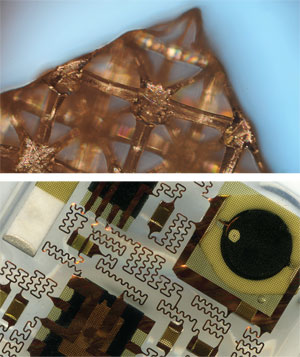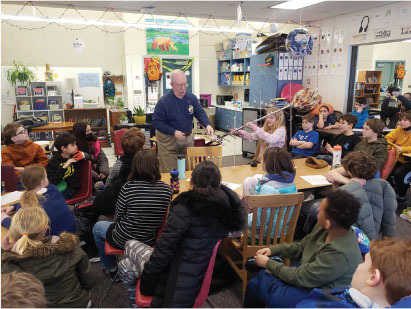March/April 2019
Variables
‘More Than Pretty Pictures’
 TOP: MICROSCOPIC IMAGE OF METAMATERIALS
TOP: MICROSCOPIC IMAGE OF METAMATERIALSBOTTOM: IMAGE OF A SOFT MICROFLUIDIC SENSOR, CAPTURED VIA A FLATBED SCANNER
Common wisdom emphasizes the importance of written and oral communication skills for engineers. Felice Frankel goes one better, asserting the need for visual communication skills as well.
Over the last 25 years, the photographer has communicated through imagery concepts in architecture, science, and engineering. In academic roles, including as a research scientist at MIT, she has taught others to do the same.
Frankel’s latest book, Picturing Science and Engineering, shows “how I do what I do.” Topics include using a flatbed scanner and microscopy, adjusting and enhancing images, and presenting work.
As Frankel emphasizes, “This is more than pretty pictures.” Imagery can help researchers and others communicate the importance of their work, she says, in ways that help the public understand and pay attention.
“I am convinced that smart, accessible, and compelling representations of science can be doors through which others can enter,” she writes.
Complicated data is more accessible when it’s graphically executed, Frankel explains, citing climate change as an example of a significant issue that can be more easily grasped when illustrated visually.
Presenting work in this way can also help engineers and scientists clarify their own thinking, Frankel notes. Telling a visual story that is “ordered and clear” means that your thinking also has to be ordered and clear. Different points of view can lead to new ways of thinking. “It’s not trivial,” she stresses. “It gives you an opportunity to think deeply about your work.”
Frankel believes that engaging with the nonexpert public should be a regular part of engineers’ and scientists’ efforts. Visual communication can help, especially if it’s embedded in education programs. Studying and critiquing visuals should be part of curricula, she believes.
With images appearing in National Geographic, Popular Science, and Newsweek, as well as on the covers of numerous journals, Frankel has made this her life’s work. She has a drive to share her own love for science and engineering with the world.
“This is ultimately my mission,” she says. “To get people to pay attention, and most important, to ask questions.” If they get engaged and curious, she says, then they’ll start to get involved. “I’m seeing it. I’m convinced of it.”
Access resources related to Picturing Science and Engineering. Learn more about Frankel and her work.


 Volunteering at NSPE is a great opportunity to grow your professional network and connect with other leaders in the field.
Volunteering at NSPE is a great opportunity to grow your professional network and connect with other leaders in the field. The National Society of Professional Engineers (NSPE) encourages you to explore the resources to cast your vote on election day:
The National Society of Professional Engineers (NSPE) encourages you to explore the resources to cast your vote on election day:
